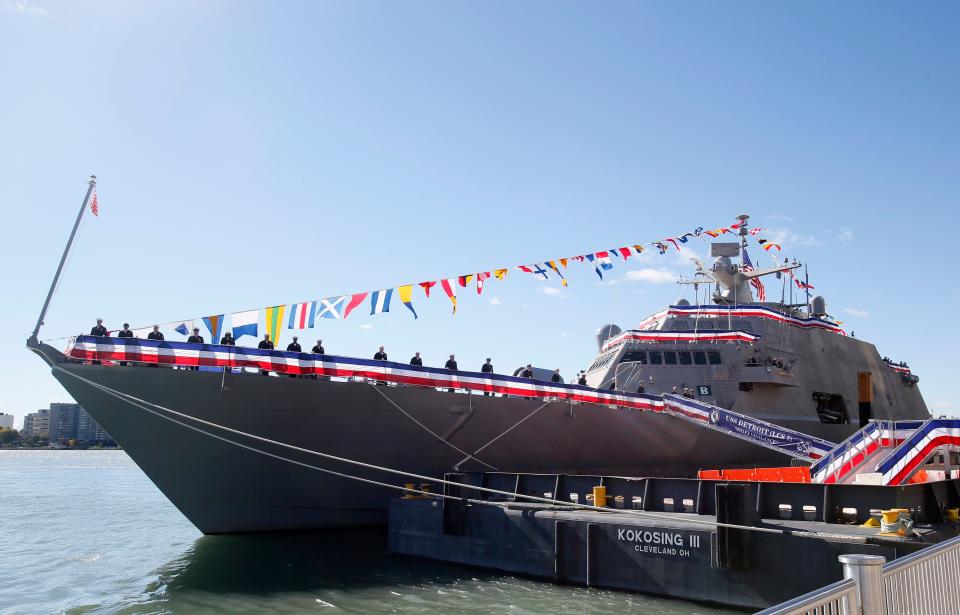Neal Rubin: The USS Detroit sails off into the sunset, and the Navy won't miss it
The warship that carries our city's name limped into a premature retirement a few weeks ago, but it's not quite fair to call it an unmitigated disaster — and whatever the ills of this Detroit, at least they weren't our fault.
All we did was throw the USS Detroit a bang-up coming-out party, not knowing that it was a train wreck of a ship from the start.
The sixth USS Detroit in our nation's naval history was officially commissioned at a dock near the Renaissance Center in October 2016, a week shy of seven years ago. It was decommissioned Sept. 29 in Jacksonville, Florida, a victim of poor timing and worse design.
“A book could be written” about the littoral combat ship (LCS) program that included the USS Detroit, said Jon Page, a clinical professor in the University of Michigan's naval architecture and marine engineering program. Lengthy articles already have been, and they have not been kind.

“But there’s a lot of good,” Page said, “that comes with what people like to characterize as bad.”
Call it a mitigated disaster, then.
Like the other ships in its class, the USS Detroit had an innovative propulsion system that never worked right. Its anti-submarine package turned out to be too big to install. The niche it was designed to fill when its program was conceived in 2002 was already bordering on irrelevance by the time it set sail.
And you know how owners refer to boats as holes in the water you pour money into? The USS Detroit swallowed $440 million before it left the Marinette Marine shipyard in Wisconsin, across the Menominee River from the U.P.
Rather than siphon more of its budget into keeping balky boats afloat, the Navy opted in the last few months to permanently park the USS Detroit, USS Little Rock, USS Sioux City and USS Milwaukee.
Half a dozen more LCS vessels have been proposed for retirement in the next two years, mostly steel monohulls like the Freedom-class USS Detroit but also some Independence-class trimarans built in Alabama, which have been prone to cracks in their aluminum hulls.

In a perfect world they have already shown does not exist, they will be sold to friendly nations who need a ship that can operate in only 14 feet of water. Or they might be given away.
Or, in a process not unknown to the USS Detroit's namesake city, they might be scrapped.
More from Neal Rubin Presto — a magical evening in Troy comes with illusions, laughs and cookies
An unprecedented error
John McCandless, 76, of St. Clair Shores, spent 32 years on active or reserve duty with the Navy. He was part of the commissioning committee that put on a multiday celebration in honor of the USS Detroit’s launch.
There were tours and sirens and speeches, with Sen. Debbie Stabenow, D-Michigan, declaring, "Like the city of Detroit, this ship is tough, resilient and in good hands.”

Unfortunately, McCandless said, the guest of honor “was an experiment, and it didn’t work out."
Only 389 feet long, the USS Detroit was supposed to zip along at up to 40 knots, or 46 mph. That required an innovative combining gear that would switch the ship from diesel power to turbine engines, assuming it worked, which it didn’t.
While the ship was supposed to be quickly convertible from a mine-hunting module to submarine detecting to surface warfare, that mostly didn’t work, either.
Meantime, across the two decades since the first LCS keels were laid, Somali buccaneers became less of a focus for the Navy than the growing nautical might of China and the general belligerence of Russia.
At least it was a good shindig. Some 4,000 people gathered at dockside, among them then-Gov. Rick Snyder, who watched committee chair John Peracchio juggle notebooks and responsibilities as they walked the deck together.
“He asked me, ‘John, why are you doing this?’ ” recalled Peracchio, 62, a transportation and mobility consultant from Grosse Pointe Shores.
“I pointed to members of the crew and said, ‘It’s really about those people, not the ship we’re standing on.’ ”
McCandless agreed. He would frequently squire visiting crews from the USS Detroit or the submarine USS Michigan to appearances and interviews in the area.
But as someone who sailed the bounding main, he said, "Over my career, I can't remember a mistake of this magnitude.”
In defense of the program
From November 2020 to February 2023, according to the ship tracker uscarriers.net, the USS Detroit sat twiddling its nautical thumbs at its home port, Mayport Naval Station in Florida. That was after it lost electrical power on its way back from Cuba.
But it rallied late in what was intended to be a 25-year career. Only days before its decommissioning, it was patrolling off the south coast of Puerto Rico.
“It is difficult to argue against the perception” that the USS Detroit and its peers are deficient, conceded Page, the U-M professor.
Still, he said, there have been benefits to the program.
Page, 43, grew up in Canton, graduated from the U.S. Naval Academy, and earned a doctorate from MIT while spending 21 years as an engineering officer — “One of the nerds of the Navy.”
He retired as a commander two months ago and joined the faculty, and if he misses the uniform, he said, he loves the new challenge and the nerves he has to battle every time he steps to the front of a classroom.

The LCS program was designed for a quick turnaround, he said, acknowledging the relativity of the term. The Navy figured out how to use research money instead of shipbuilding money to speed the process, and how to streamline discussions with Congress; otherwise, the first ships might be churning from the yards only now.
The USS Detroit and the others used alternating crews, he said, something previously limited to submarines, and the experiment worked.
The Navy absorbed a hard lesson about testing new technology on the fly, or rather on the water; there’s now a land-based test site in Philadelphia, so that something akin to the combining gear will be proven before it's installed.
“What we learned as a Navy and a nation,” he said, will make the next programs better.
With 35 ships built or under construction and billions of dollars invested, it’s been an expensive lesson, and whatever the USS Detroit might sell for at the used-ship lot will only be a drop in the ocean.
It will be given a different name, of course, and it will likely stick closer to home than it did before, operated with less lofty ambitions.
But Page likes thinking that the USS Detroit will still be making the seas safer — and as the city of Detroit can attest, it’s better to be scrappy than scrap.
Contact Neal Rubin: NARubin@freepress.com.
To subscribe to the Free Press for significantly less than the cost of a littoral combat ship, and without Congressional permission, click here.
This article originally appeared on Detroit Free Press: USS Detroit, victim of bad timing and worse design, goes out of service

